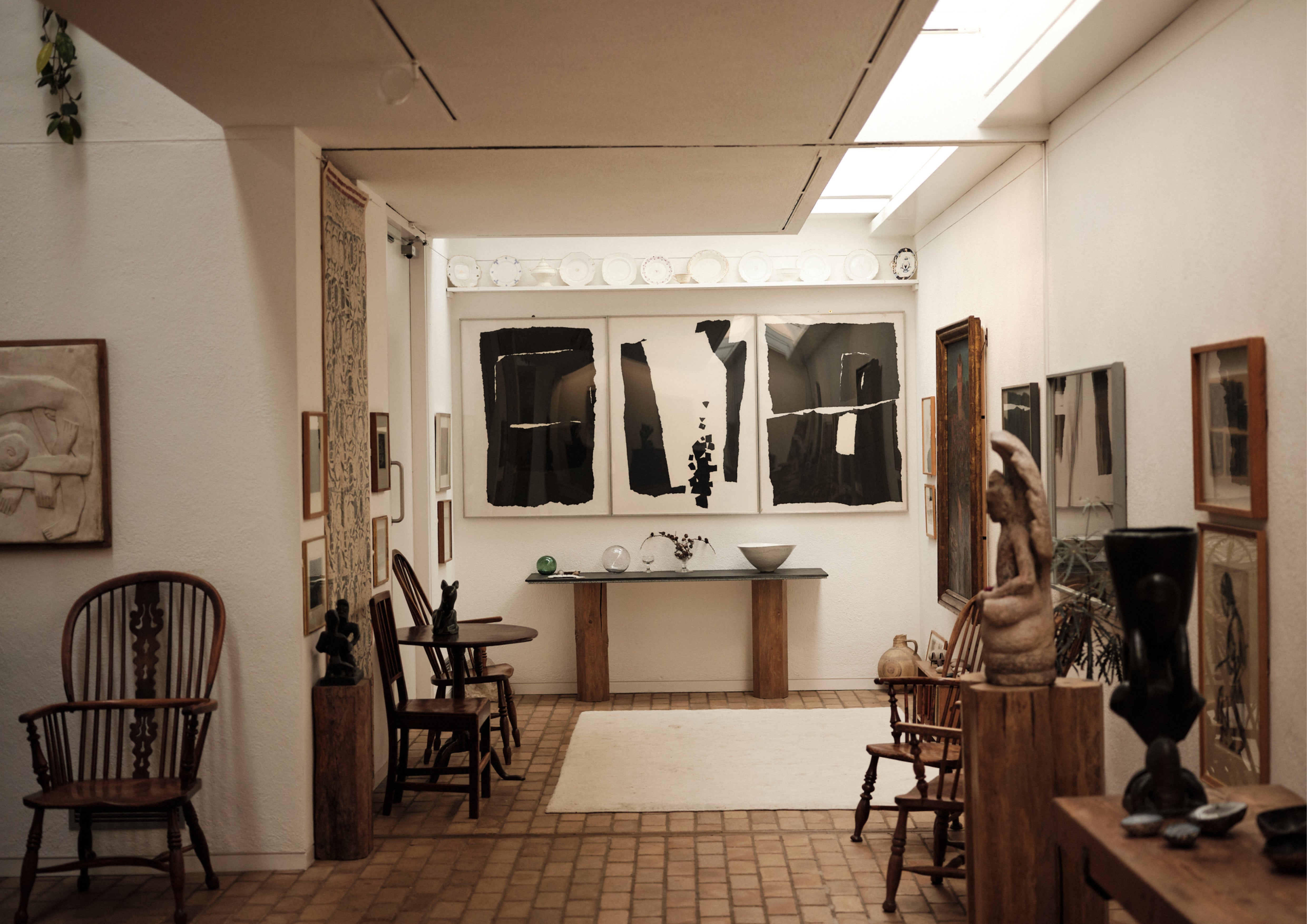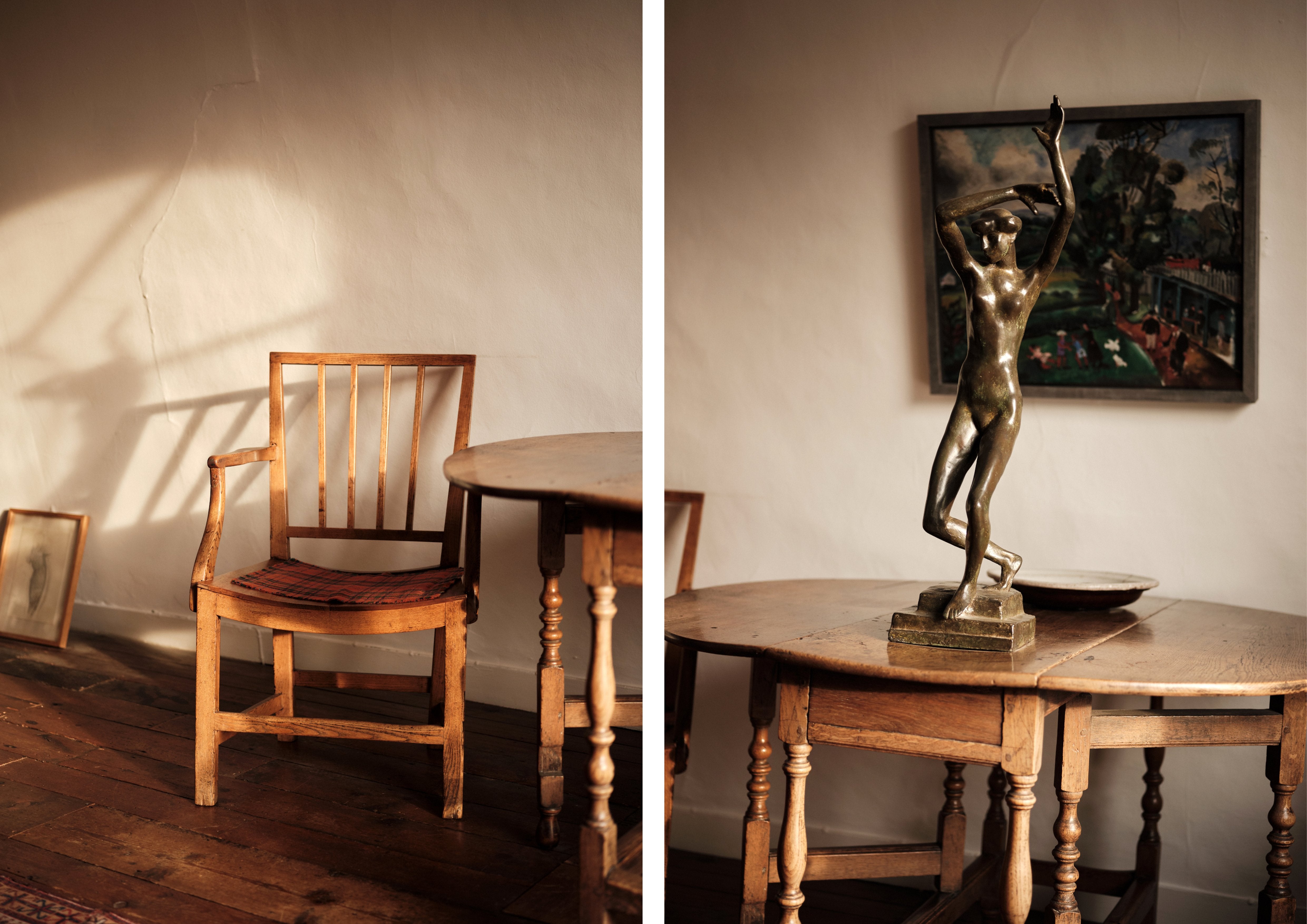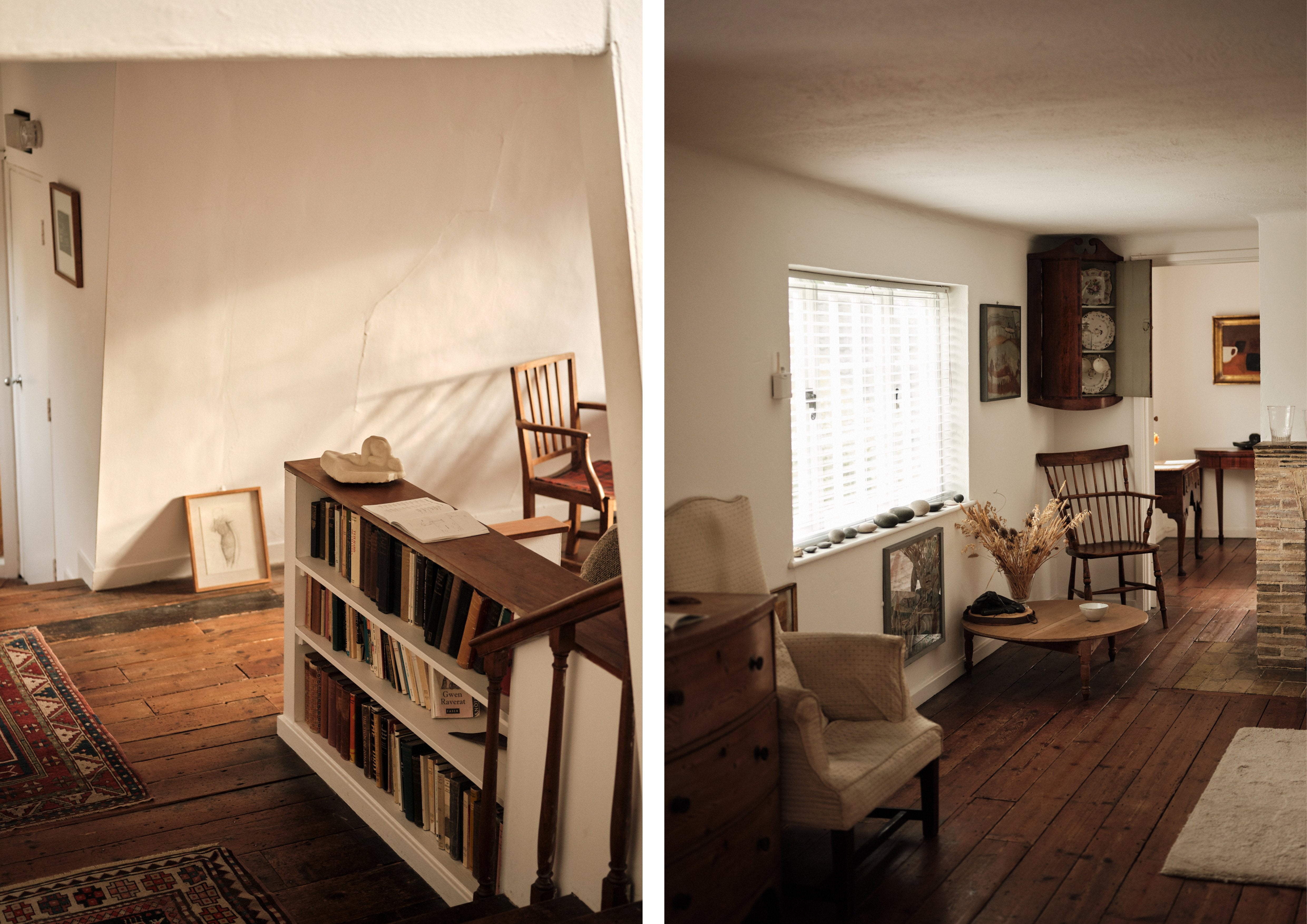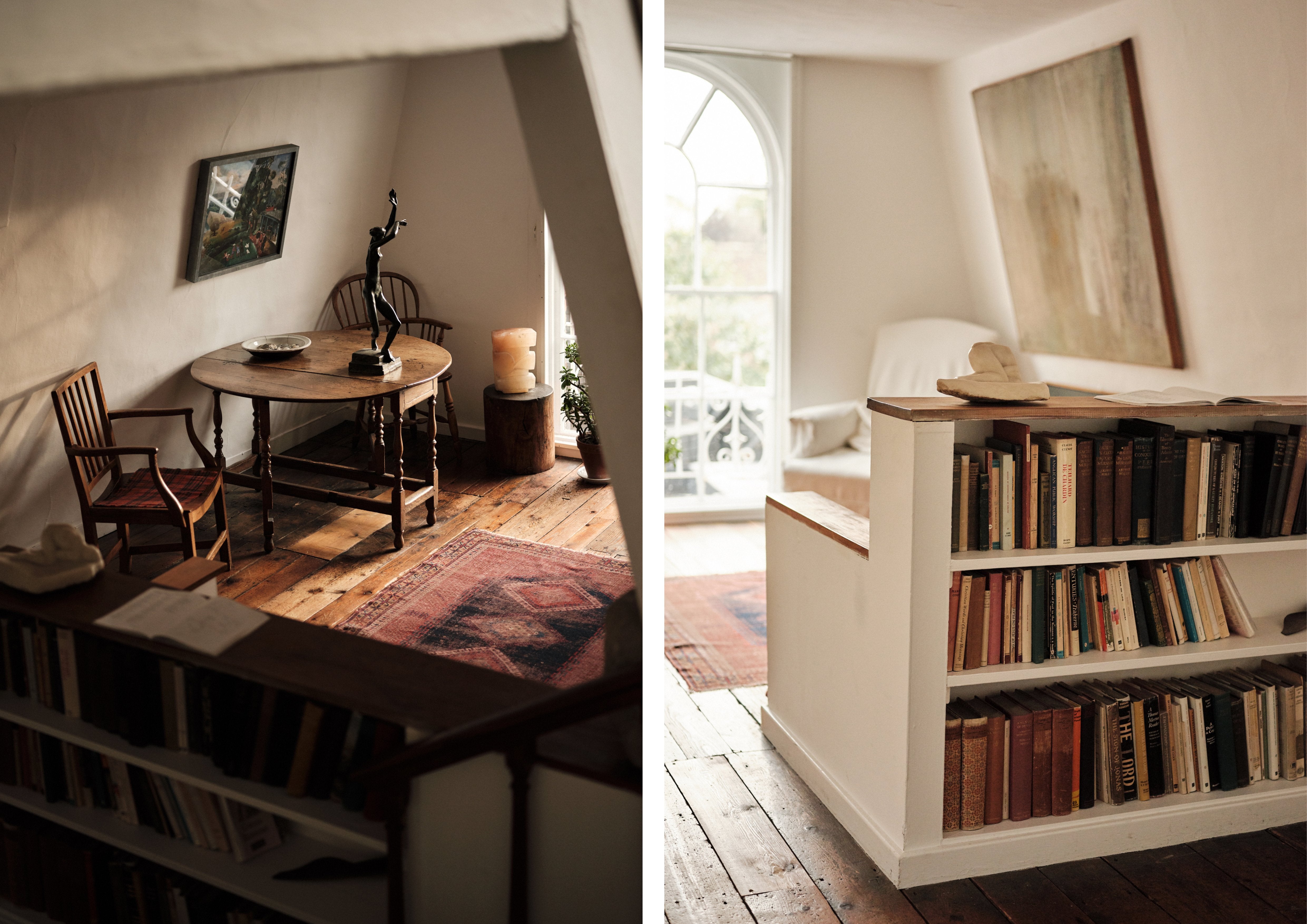
We explore the history behind Kettle's Yard in Cambridge, originally the home of Jim and Helen Ede between 1957 and 1973.
Come in as often as you like, the place is only alive when used
These words of welcome, written by creator Jim Ede in a letter of 1964, present the openness and generosity that embody Kettle's Yard, Cambridge. Known as much for its outstanding collection of twentieth-century art by the likes of Barbara Hepworth, Ben Nicholson and Henry Moore, as for its careful arrangement of natural objects such as pebbles, feathers and shells, Kettle's Yard exists to provide a home for anyone who wishes to enter.
Comprised of a group of small eighteenth-century workers' cottages with a 1970s extension, Kettle's Yard sits on a quiet edge of the city centre, nestled between a small garden of hollyhocks and medlar trees and a tiny Norman church whose yard brims full with waist-height wildflowers in spring. The cottages were saved from demolition by Ede and his wife Helen in 1957 and the couple filled them with their extraordinary collection of art, natural objects, plants, furniture, textiles, ceramics and glassware over the course of the next sixteen years.


Born in 1895, near Cardiff, Ede was interested in art and beautiful objects from a young age. The story goes that when his father gave him, aged fourteen, a small amount of money to buy a bicycle he spent it on a bureau that still stands at the opening to his bedroom in Kettle's Yard. He visited the museums of Paris with his family as a child before going on to discover paintings of the Italian Renaissance at the Fitzwilliam Museum in Cambridge during a period at school in the city between 1909 and 1912. Ede enlisted during the First World War and was sent back from the front in 1916 suffering from physical and mental exhaustion. It has been suggested that the creation of Kettle's Yard was the culmination of a life spent nurturing spaces for art and people that served as retreats from the world, in response to his traumatising experience in the trenches.


Jim Ede met Helen Schlapp, daughter of a Professor of German at the University of Edinburgh, at the Edinburgh College of Art and they went on to marry in 1921. Later that year, Ede joined the National Gallery of British Art (renamed the Tate Gallery in 1932) as a curator and assistant to the gallery's director of contemporary art. His work at the Tate brought him into contact with some of the most important artists of the time and work-related trips to Paris led him to meet key figures of the artistic avant-garde, including Pablo Picasso, Marc Chagall, Joan Mir and Constantin Brancusi. Ede became close friends with artists who were significant in the development of twentieth-century British modernism such as Ben and Winifred Nicholson, Henry Moore, Christopher Wood and David Jones.
The Edes' home on Elm Row in Hampstead, London, became a hub for contemporary cultural figures in the 1920s and 1930s, with musicians, writers and dancers gathering with artists to share and discuss work and ideas. Ede left the Tate in 1936, resigning over his frustration at the reluctance to move away from the gallery leadership's more conservative taste. The Edes went on to spend the next twenty years living in Tangier, Morocco, and the Loire Valley in France, collecting items of furniture, textiles and other objects as they went. In 1941, he went on the first of three tours of the United States to give lectures on artists including Henri Gaudier-Brzeska, a French artist whose work he greatly admired and was dedicated to promoting. While in America, he met and befriended other important contemporary artists whose work can be found in Kettle's Yard including William Congdon and Richard Pousette-Dart.


These friendships and encounters with the artistic avant-garde shaped Ede's interest in art and his exploration of its role in everyday life. Throughout his life he befriended many emerging artists and supported their careers in any way he could, buying their work himself, encouraging institutions to purchase works for their collection, or helping to attract the patronage of other individuals. This support was reciprocated by many of these artists as they achieved success and many of the items in the Kettle's Yard collection were gifts from Ede's artist friends, some of which are personally signed To Jim'. He would later describe himself as, above all, a friend of artists'.
Once the Edes had set up their home at Kettle's Yard, their friends would visit Cambridge for evenings of art, poetry, discussion and music. Music continues to play an important role at Kettle's Yard, with weekly lunchtime concerts by university students in the beautiful surrounds of the 1970s extension by architects Leslie Martin and David Owers, as well as a chamber music series and an ambitious programme of new music, all with the express Ede-like intent of supporting young musicians and contemporary composition.


The inventory of objects in Kettle's Yard easily surpasses one thousand. Yet the prevailing feeling inside the house is one of peacefulness and quiet order. It is not minimalist - there is a new object or artwork to discover everywhere you look - yet Ede's careful arrangement of his collection against whitewashed walls and bare wooden floorboards allows you to look without distraction. A sculpture by Henri Gaudier-Brzeska is placed atop a large piece of driftwood found on a beach in the Scilly Isles (Bird Swallowing a Fish, 1914), a Constantin Brancusi cement head rests on the piano (Prometheus, 1912) and a Max Ernst drawing leans on the floor, propped up against the wall (Figure, 1925). Fresh flowers are interspersed amongst fossils, another Gaudier-Brzeska sits next to a dried rose of Jericho (Torpedo Fish (Toy), 1914) and an Alfred Wallis painting is placed on the cistern in the bathroom (Grey steam boat, undated).
There is no hierarchy in the collection at Kettle's Yard, everything is arranged so as to prompt aesthetic enjoyment and conversation between objects, be it through their form, texture, colour or proportion, or as a result of the changing shadows and reflections that pass across the house throughout the days and seasons. There are no labels to tell you whether Ben Nicholson drew a particular work or if it is by the Edes' granddaughter, what is a priceless sculpture and what is an old broom-head, what is bronze and what is painted plaster. Everything takes its own place and is of equal value.


Ede was especially interested in the relationship between opposites: light and dark, heavy and weightless, hard and soft. He moved objects and artworks around to find arrangements which drew attention to these contrasts and subverted preconceptions. These deliberate juxtapositions sought to provide balance, which was of the utmost important for Ede. A particularly poignant example of Ede's mastering of balance is his placing of a lemon on a pewter dish in the living room; its citron yellow shades bounce around the room, drawing out the bright yellow dot in the nearby Mir painting Tic Tic (1927), the fresh yellow flowers on the table opposite and the wilting daffodils in Christopher Wood's Flowers (1930) beneath the window. Ede would cover up the dot in the Mir to demonstrate to visitors how the painting itself depended on the artist's perfect balance of shape and colour. He wrote that the painting gave me a much needed chance to mention God, and by saying that if I had another name for God, I think it would be balance, for with perfect balance all would be well'.


Other opportunities to discover relationships between artworks and objects at Kettle's Yard are found in the seating arrangements. You are encouraged to sit in one or more of the nearly fifty chairs that Ede set about the house, including a traditional straw-backed Orkney chair, a centuries-old Scandinavian folk chair made from the trunk of a tree and an assortment of Windsor chairs, as well as a soft long sofa made of two mattresses. Despite often being of more traditional design than the art it lives amongst, the seating is arranged in original ways that provide new perspectives on the collection and house itself. When you sit in the high-backed cream chair opposite the Bechstein piano in the upstairs living room, for instance, you notice how the two grey armchairs next to the dark piano draw out the palette of the Roger Hilton oil painting above (October 1955 Calm (Black, Grey, Brown and White), 1955). Similarly, when you sit in one of the low grey armchairs, the rooftops and spires of Cambridge colleges, libraries and chapels that are visible through the window seem to relate to the landscape in David Jones' painting of Lourdes beneath (Lourdes, 1928).

Ede wanted Kettle's Yard to be a living place where works of art would be enjoyed, inherent to the domestic setting, where young people could be at home unhampered by the greater austerity of the museum or public art gallery, and where an informality might infuse an underlying formality'. Anyone who wanted to visit was invited to ring the doorbell between 2-5pm every day, including Sunday. They would be welcomed by Ede with lapsang souchong tea and toast and he would engage them in conversation about the collection. Ede partly chose Cambridge as the location for Kettle's Yard because it was a university town and students were particularly encouraged to visit. Ede created a student loan scheme through which members of the university could borrow works for their room in exchange for a small deposit. Many early visitors to Kettle's Yard recall this intimate, trusting engagement with an artwork as being instrumental in forging a lifelong love of art, and often a choice of career. The student loan scheme runs to this day for students at Anglia Ruskin University and the University of Cambridge and includes works by Italo Valenti, Kate Nicholson and Bryan Pearce.

Jim and Helen Ede lived at Kettle's Yard until 1973, before returning to Edinburgh. Ede's determination to introduce his art to as many people as possible had led to his decision to gift the house and its contents to the University of Cambridge in 1966, in whose possession it remains. The Edes expressed the desire that Kettle's Yard and its collection would remain as they were when they lived there; a place in which art and nature intertwine and become a way of life'. The house now welcomes over 200,000 visitors a year to come as often as they like. They ring the clanging doorbell, sit in the creaking chairs, smell the delicate lemon pelargoniums and watch the rainbowed light refracted onto paintings and pebbles, making the Edes' home truly alive, or in Jim's words a space, an ambience, a home'.
Words by Susy Oram. Images by Liz Seabrook.
The quotations in this article are taken from Jim Ede's correspondence in the archive at Kettle's Yard and from his book A Way of Life, available from Kettle's Yard Shop.
About Kettle's Yard
Kettle's Yard, Cambridge was the home of Jim and Helen Ede between 1957 and 1973. Housed inside four converted eighteenth-century workers' cottages with a 1970s extension, its permanent collection includes works by Constantin Brancusi, Barbara Hepworth, Henry Moore and Joan Mir. A further extension by Jamie Fobert Architects was opened in 2018 and includes two gallery spaces which seek to continue Jim Ede's support for emerging and established artists and host an exhibition programme which has included the work of Louise Bourgeois, Antony Gormley and Oscar Murillo.
Add a comment